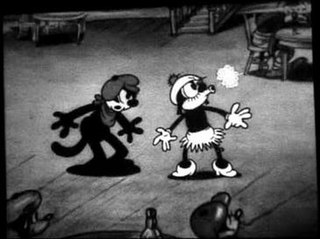
George Joseph Herriman III was an American cartoonist best known for the comic strip Krazy Kat (1913–1944). More influential than popular, Krazy Kat had an appreciative audience among those in the arts. Gilbert Seldes' article "The Krazy Kat Who Walks by Himself" was the earliest example of a critic from the high arts giving serious attention to a comic strip. The Comics Journal placed the strip first on its list of the greatest comics of the 20th century. Herriman's work has been a primary influence on cartoonists such as Elzie C. Segar, Will Eisner, Charles M. Schulz, Robert Crumb, Art Spiegelman, Bill Watterson, and Chris Ware.

Krazy Kat is an American newspaper comic strip, created by cartoonist George Herriman, which ran from 1913 to 1944. It first appeared in the New York Evening Journal, whose owner, William Randolph Hearst, was a major booster for the strip throughout its run. The characters had been introduced previously in a side strip with Herriman's earlier creation, The Dingbat Family, after earlier appearances in the Herriman comic strip Baron Bean. The phrase "Krazy Kat" originated there, said by the mouse by way of describing the cat. Set in a dreamlike portrayal of Herriman's vacation home of Coconino County, Arizona, KrazyKat's mixture of offbeat surrealism, innocent playfulness and poetic, idiosyncratic language has made it a favorite of comics aficionados and art critics for more than 80 years.

Rodeo Dough is a 1931 American short animated Western film by Columbia Pictures, and stars the comic strip character Krazy Kat.
Seeing Stars is a 1932 short animated film distributed by Columbia Pictures, and features Krazy Kat. Different from most shorts of the series, the cartoon features celebrities in their animated forms.

The Apache Kid is a 1930 cartoon short distributed by Columbia Pictures and features Krazy Kat. The film is the character's 149th film.
Lil' Ainjil is a 1936 short animated film distributed by Columbia Pictures, and features Krazy Kat.

The Stork Exchange is a 1927 silent animated short film starring Krazy Kat. This film was thought to be lost but has been found. It is also one of the earliest in the cartoon series to feature Manny Gould and Ben Harrison's version of Krazy, the first of few incarnations derived from George Herriman's famous character.

Rail Rode is a 1927 silent short animated film released by Paramount featuring Krazy Kat.
The Mouse Exterminator is a 1940 short animated film in the Phantasies series, produced and distributed by Columbia Pictures. It marks the final theatrical appearance of Krazy Kat, the title character from George Herriman's comic strip.
Krazy Kat and Ignatz Mouse: A Duet, He Made Me Love Him, also simply known as A Duet, is a 1916 silent short animated film featuring Krazy Kat. It is among the earliest cartoons to feature Krazy who earlier achieved modest success through comic strips.
Krazy Kat & Ignatz Mouse Discuss the Letter 'G' is a 1916 silent short animated film featuring the comic strip character Krazy Kat. As with other animated shorts at the time, it was featured as an extra along with news reports that were released on film.
The Best Mouse Loses is a 1920 silent short theatrical cartoon by Bray Productions featuring Krazy Kat.
Dentist Love is a silent short animated film by Winkler Pictures, and among the many starring the comic strip character Krazy Kat.

Slow Beau is a 1930 short animated film distributed by Columbia Pictures, starring Krazy Kat. The film also marks the debut of Krazy's second theme song which would have a much longer run than his first.
The Crystal Gazabo is a 1932 American Pre-Code short animated film distributed by Columbia Pictures, and one of the numerous featuring Krazy Kat.
The Lone Mountie is a 1938 short animated film by Columbia Pictures, and part of the long-running Krazy Kat film series.
The Great Cheese Robbery is a silent short animated film made by Bray Productions featuring Krazy Kat. It marks the first Krazy film produced by Bray after the International Film Service (IFS) ended its run in making films in the series.
A Family Affair is a silent short animated film by Bray Productions featuring Krazy Kat. It is the sixth Krazy short produced by the studio.
The Awful Spook is a silent short animated film created by the Bray Studio, featuring Krazy Kat.
Events in 1916 in animation.






